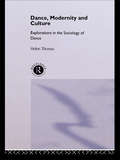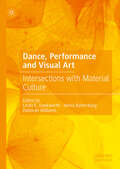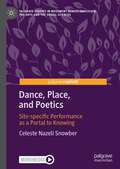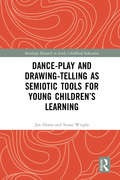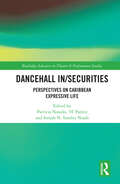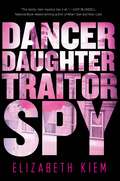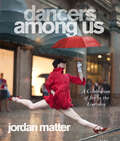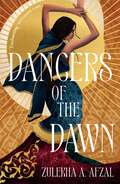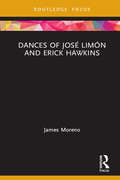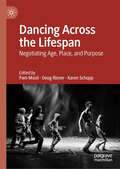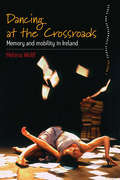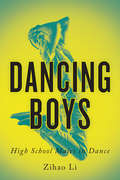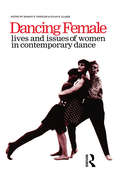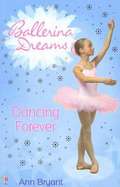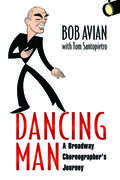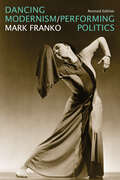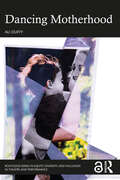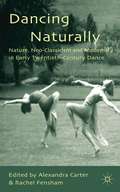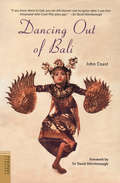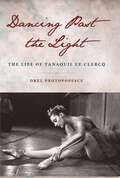- Table View
- List View
Dance, Modernity and Culture
by Helen ThomasFirst published in 1995. Routledge is an imprint of Taylor & Francis, an informa company.
Dance, Performance and Visual Art: Intersections with Material Culture
by Deborah Williams Linda E. Dankworth Henia RottenbergThis collection presents a selection of essays written from a point of view that has dance, movement, or performance at its centre, and examines the intellectual and material relationship to the art form from which they are conceived. The themes that emerge from the authors’ contributions signify a desire to explore individual techniques in making art or unravelling the techniques of others within the composition of visual art and its contemporary movement language. Similarly, textual, and pictorial representations depict both antiquated and modern art and all their social aspects of human life. Digitization also remains a strong focus in both dance and its representation in performance contexts and place in social constructs of societies.
Dance, Place, and Poetics: Site-specific Performance as a Portal to Knowing (Palgrave Studies in Movement across Education, the Arts and the Social Sciences)
by Celeste Nazeli SnowberThis book explores the relationship between the body, ecology, place, and site-specific performance. The book is situated within arts-based research, particularly within embodied inquiry and poetic inquiry. It explores a theoretical foundation for integration of these areas, primarily to share the lived experiences, poetry and dance which have come out of decades of sharing site-specific performances.
Dance-Play and Drawing-Telling as Semiotic Tools for Young Children’s Learning (Routledge Research in Early Childhood Education)
by Susan Wright Jan DeansInvestigating children’s learning through dance and drawing-telling, Dance-Play and Drawing-Telling as Semiotic Tools for Young Children’s Learning provides a unique insight into how these activities can help children to critically reflect on their own learning. Promoting the concept of dance and drawing-telling as highly effective semiotic tools for meaning-making, the book enlivens thinking about the extraordinary capacities of young children, and argues for the incorporation of dance and drawing in mainstream early childhood curriculum. Throughout the book, numerous practice examples show how children use movement, sound, images, props and language to imaginatively re-conceptualize their everyday experiences into bodily-kinesthetic and spatial-temporal concepts. These examples illustrate children’s competence when given the opportunity to learn through dance and drawing-telling, as well as the important role that teachers play in scaffolding children’s learning. Based on award-winning research, this insightful and informative book makes a sought after contribution to the field of dance education and seeks to reaffirm dance as a powerful learning modality that supports young children’s expressive non-verbal communication. Encouraging the reader to consider the significance of multi-modal teaching and learning, it is essential reading for researchers in the dance, drawing and education spheres; postgraduate students taking courses in early childhood; play and dance therapists; and all early childhood teachers who have a specific interest in arts education.
Dancehall In/Securities: Perspectives on Caribbean Expressive Life (Routledge Advances in Theatre & Performance Studies)
by Patricia Noxolo ‘h’ Patten Sonjah N. Stanley NiaahThis book focuses on how in/security works in and through Jamaican dancehall, and on the insights that Jamaican dancehall offers for the global study of in/security. This collection draws together a multi-disciplinary range of key scholars in in/security and dancehall. Scholars from the University of the West Indies' Institute of Caribbean Studies and Reggae Studies Unit, as well as independent dancehall and dance practitioners from Kingston, and writers from the UK, US and continental Europe offer their differently situated perspectives on dancehall, its histories, spatial patterning, professional status and aesthetics. The study brings together critical security studies with dancehall studies and will be of great interest to students, scholars and practitioners in theatre, dance and performance studies, sociology, cultural geography, anthropology, postcolonial studies, diaspora studies, musicology and gender studies.
Dancer, Daughter, Traitor, Spy
by Elizabeth KiemA new breed of spy novel combines classic thrills (The Americans, John Le Carre, and Alan Furst), Bolshoi intrigue, and elements of the paranormal.Marina is born of privilege. Her mother, Sveta, is the Soviet Union's prima ballerina: an international star handpicked by the regime. But Sveta is afflicted with a mysterious second sight and becomes obsessed with exposing a horrific state secret. Then she disappears. Fearing for their lives, Marina and her father defect to Brooklyn. Marina struggles to reestablish herself as a dancer at Juilliard. But her enigmatic partner, Sergei, makes concentration almost impossible, as does the fact that Marina shares her mother's "gift," and has a vision of her father's murder at the hands of the Russian crooks and con artists she thought they'd left behind. Now Marina must navigate the web of intrigue surrounding her mother's disappearance, her ability, and exactly whom she can--and can't--trust.From the Hardcover edition.
Dancers Among Us: A Celebration of Joy in the Everyday
by Jordan MatterThe mystery of the body in motion. The surprise of seeing what seems impossible. And the pure, joyful optimism of it all. Dancers Among Us presents one thrilling photograph after another of dancers leaping, spinning, lifting, kicking—but in the midst of daily life: on the beach, at a construction site, in a library, a restaurant, a park. With each image the reader feels buoyed up, eager to see the next bit of magic.Photographer Jordan Matter started his Dancers Among Us Project by asking a member of the Paul Taylor Dance Company to dance for him in a place where dance is unexpected. So, dressed in a commuter’s suit and tie, the dancer flew across a Times Square subway platform. And in that image Matter found what he’d been searching for: a way to express the feeling of being fully alive in the moment, unself-conscious, present.Organized around themes of work, play, love, exploration, dreaming, and more, Dancers Among Us celebrates life in a way that’s fresh, surprising, original, universal. There’s no photoshopping here, no trampolines, no gimmicks, no tricks. Just a photographer, his vision, and the serendipity of what happens when the shutter clicks.
Dancers of the Dawn (Dancers of the Dawn #1)
by Zulekhá A. AfzalDeep in the desert a storm is brewing. The first in a sweeping YA fantasy duology. 'Enchanting.' Katharine Corr, co-author of Daughter of Darkness Under the blazing sun, an elite troupe of dancers are trained to harness their magic. They are the queen&’s most formidable assassins. Aasira has one of the rarest talents – for she is a flame-wielder. Feared by all and envied by some, she uses her power to execute enemies of the crown. Aasira&’s greatest wish is to serve her queen. But on the eve of her graduation, with tensions rising among the dancers and secrets stirring in the shifting sand dunes, she begins to question whether she was truly born to kill… Readers are spellbound by Dancers of the Dawn: &‘Hands down, one of the best books I'll read this year&’ ⭐⭐⭐⭐⭐ &‘a suspenseful, plot twisty and powerfully emotional read that epic fantasy lovers definitely don&’t want to miss.&’ ⭐⭐⭐⭐⭐ &‘Absolutely stellar… I love the sisterhood, the mystery, the characters, the magic.&’ ⭐⭐⭐⭐⭐ &‘an excellent fantasy featuring an original magical system, well developed characters, and a fascinating plot.&’ ⭐⭐⭐⭐⭐ &‘absolutely gorgeous, so evocative that I could practically hear the music and see the dancers, even in their deadliest moments.&’ ⭐⭐⭐⭐⭐ &‘This world is rich, vibrant, and colorful, the prose will transport you to a land full of spices and secrets.&’ ⭐⭐⭐⭐⭐ &‘First of all, dance magic? Such a unique magic system and it was done beautifully! The world was perfectly described, with the spices and the flowers and all the colours. I just adored it!&’ ⭐⭐⭐⭐⭐ &‘A beautifully evoked and action-packed YA adventure, with awe inspiring description of both landscape, magic and dance.&’ ⭐⭐⭐⭐⭐
Dances of José Limón and Erick Hawkins (Routledge Advances in Theatre & Performance Studies)
by James MorenoDances of José Limón and Erick Hawkins examines stagings of masculinity, whiteness, and Latinidad in the work of US modern dance choreographers, José Limón (1908-1972) and Erick Hawkins (1908-1994). Focusing on the period between 1945 to 1980, this book analyzes Limón and Hawkins’ work during a time when modern dance was forming new relationships to academic and governmental institutions, mainstream markets, and notions of embodiment. The pre-war expressionist tradition championed by Limón and Hawkins’ mentors faced multiple challenges as ballet and Broadway complicated the tenets of modernism and emerging modern dance choreographers faced an increasingly conservative post-war culture framed by the Cold War and Red Scare. By bringing the work of Limón and Hawkins together in one volume, Dances of José Limón and Erick Hawkins accesses two distinct approaches to training and performance that proved highly influential in creating post-war dialogues on race, gender, and embodiment. This book approaches Limón and Hawkins’ training regimes and performing strategies as social practices symbiotically entwined with their geo-political backgrounds. Limón’s queer and Latino heritage is put into dialogue with Hawkins’ straight and European heritage to examine how their embodied social histories worked co-constitutively with their training regimes and performance strategies to produce influential stagings of masculinity, whiteness, and Latinidad.
Dancing Across the Lifespan: Negotiating Age, Place, and Purpose
by Karen Schupp Doug Risner Pam MusilThis book critically examines matters of age and aging in relation to dance. As a novel collection of diverse authors’ voices, this edited book traverses the human lifespan from early childhood to death as it negotiates a breadth of dance experiences and contexts. The conversations ignited within each chapter invite readers to interrogate current disciplinary attitudes and dominant assumptions and serve as catalysts for changing and evolving long entrenched views among dancers regarding matters of age and aging.The text is organized in three sections, each representing a specific context within which dance exists. Section titles include educational contexts, social and cultural contexts, and artistic contexts. Within these broad categories, each contributor’s milieu of lived experiences illuminate age-related factors and their many intersections. While several contributing authors address and problematize the phenomenon of aging in mid-life and beyond, other authors tackle important issues that impact young dancers and dance professionals.
Dancing At The Crossroads
by Helena WulffDancing at the crossroads used to be young people's opportunity to meet and enjoy themselves on mild summer evenings in the countryside in Ireland until this practice was banned by law, the Public Dance Halls Act in 1935. Now a key metaphor in Irish cultural and political life, "dancing at the crossroads" also crystallizes the argument of this book: Irish dance, from Riverdance (the commercial show) and competitive dancing to dance theatre, conveys that Ireland is to be found in a crossroads situation with a firm base in a distinctly Irish tradition which is also becoming a prominent part of European modernity.
Dancing Boys: High School Males in Dance
by Zihao LiThe challenges that young women go through in order to be successful in the world of dance are well known. However, little is known about the experiences of young men who choose to take dance classes in non-professional settings. Dancing Boys is one of the first scholarly works to demystify the largely unknown challenges of adolescent males in dance. Through an ethnographic study of sixty-two adolescent male students, Zihao Li captures the authentic stories and experiences of boys participating in dance classes in a public high school in Toronto. Accompanied by the boys' artwork and photographs and supported by a documentary-style video, the study explores their motivations for dancing, their reflections on masculinity and gender, and the internal and external factors that impact their decisions to continue to dance professionally or in informal settings. With the author's reflections on his own journey as a professional dancer woven throughout, Dancing Boys will spark discussion on how and why educators can engage adolescent males in dance.
Dancing Cultures
by Jonathan Skinner Helene Neveu KringelbachDance is more than an aesthetic of life - dance embodies life. This is evident from the social history of jive, the marketing of trans-national ballet, ritual healing dances in Italy or folk dances performed for tourists in Mexico, Panama and Canada. Dance often captures those essential dimensions of social life that cannot be easily put into words. What are the flows and movements of dance carried by migrants and tourists? How is dance used to shape nationalist ideology? What are the connections between dance and ethnicity, gender, health, globalization and nationalism, capitalism and post-colonialism? Through innovative and wide-ranging case studies, the contributors explore the central role dance plays in culture as leisure commodity, cultural heritage, cultural aesthetic or cathartic social movement.
Dancing Female (Choreography and Dance Studies Series #Vol. 12)
by Sharon E. Friedler Susan B. GlazerFirst Published in 1997. Routledge is an imprint of Taylor & Francis, an informa company.
Dancing Forever (Ballerina Dreams #6)
by Ann BryantWhen a boy joins Rose's ballet class, she finds him exciting and funny. Wanting badly to be friends, she allows herself to be distracted from her ballet. Seeing her distraction, the teacher questions Rose's devotion to being an excellent ballerina. Will Rose still be allowed to test to advance to the next class where she can be with her friends, Poppy and Jasmine?
Dancing Indigenous Worlds: Choreographies of Relation
by Jacqueline Shea MurphyThe vital role of dance in enacting the embodied experiences of Indigenous peoples In Dancing Indigenous Worlds, Jacqueline Shea Murphy brings contemporary Indigenous dance makers into the spotlight, putting critical dance studies and Indigenous studies in conversation with one another in fresh and exciting new ways. Exploring Indigenous dance from North America and Aotearoa (New Zealand), she shows how dance artists communicate Indigenous ways of being, as well as generate a political force, engaging Indigenous understandings and histories.Following specific dance works over time, Shea Murphy interweaves analysis, personal narrative, and written contributions from multiple dance artists, demonstrating dance&’s crucial work in asserting and enacting Indigenous worldviews and the embodied experiences of Indigenous peoples. As Shea Murphy asserts, these dance-making practices can not only disrupt the structures that European colonization feeds upon and strives to maintain, but they can also recalibrate contemporary dance. Based on more than twenty years of relationship building and research, Shea Murphy&’s work contributes to growing, and largely underreported, discourses on decolonizing dance studies, and the geopolitical, gendered, racial, and relational meanings that dance theorizes and negotiates. She also includes discussions about the ethics of writing about Indigenous knowledge and peoples as a non-Indigenous scholar, and models approaches for doing so within structures of ongoing reciprocal, respectful, responsible action.
Dancing Man: A Broadway Choreographer's Journey
by Bob AvianTony and Olivier Award–winning Bob Avian’s dazzling life story, Dancing Man: A Broadway Choreographer’s Journey, is a memoir in three acts. Act I reveals the origins of one of Broadway’s legendary choreographers who appeared onstage with stars like Barbra Streisand and Mary Martin all before he was thirty. Act II includes teaching Katharine Hepburn how to sing and dance in Coco and working with Stephen Sondheim and Michael Bennett while helping to choreograph the original productions of Company and Follies. During this time, Avian won a Tony Award as the cochoreographer of A Chorus Line and produced the spectacular Tony Award–winning Dreamgirls. For a triumphant third act, Avian choreographed Julie Andrews’s return to the New York stage, devised all of the musical staging for Miss Saigon and Sunset Boulevard, and directed A Chorus Line on Broadway. He worked with the biggest names on Broadway, including Andrew Lloyd Webber, Carol Burnett, Jennifer Holliday, Patti LuPone, Elaine Stritch, and Glenn Close. Candid, witty, sometimes shocking, and always entertaining, here at last is the ultimate up-close and personal insider’s view from a front row seat at the creation of the biggest, brightest, and best Broadway musicals of the past fifty years.
Dancing Modernism / Performing Politics
by Mark FrankoIn the much-anticipated update to a classic in dance studies, Mark Franko analyzes the political aspects of North American modern dance in the 20th century.A revisionary account of the evolution of modern dance, this revised edition of Dancing Modernism / Performing Politics features a foreword by Juan Ignacio Vallejos on Franko's career, a new preface, a new chapter on Yvonne Rainer, and an appendix of left-wing dance theory articles from the 1930s. Questioning assumptions that dancing reflects culture, Franko employs a unique interdisciplinary approach to dance analysis that draws from cultural theory, feminist studies, and sexual, class, and modernist politics. Franko also highlights the stories of such dancers as Isadora Duncan, Martha Graham, and even revolutionaries like Douglas Dunn in order to upend and contradict ideas on autonomy and traditionally accepted modernist dance history.Revealing the captivating development of modern dance, this revised edition of Dancing Modernism / Performing Politics will fascinate anyone interested in the intersection of performance studies, history, and politics.
Dancing Motherhood (Routledge Series in Equity, Diversity, and Inclusion in Theatre and Performance)
by Ali DuffyDancing Motherhood explores how unique factors about the dance profession impact pregnant women and mothers working in it. Ali Duffy introduces the book by laying a foundation of social and cultural histories and systemic structures and power that shape the issues mothers in dance negotiate today. This book then reveals perspectives from mothers in dance working in areas such as performance, choreography, dance education, administration, and advocacy though survey and interview data. Based on participant responses, recommendations for changes in policy, hiring, evaluation, workplace environment, and other professional and personal practices to better support working mothers in dance are highlighted. Finally, essays from eight working mothers in dance offer intimate, personal stories and guidance geared to mothers, future mothers, policymakers, and colleagues and supervisors of mothers in the dance field. By describing lived experiences and offering suggestions for improved working conditions and advocacy, this book initiates expanded discussion about women in dance and promotes change to positively impact dancing mothers, their employers, and the dance field.
Dancing Naturally
by Alexandra Carter Rachel FenshamA renewed interest in nature, the ancient Greeks, and the freedom of the body was to transform dance and physical culture in the early twentieth century. The book discusses the creative individuals and developments in science and other art forms that shaped the evolution of modern dance in its international context.
Dancing On My Grave
by Gelsey Kirkland Greg LawrenceThe shattering story of a dream which became a heartbreaking nightmare for one of America's most famous ballerinas, Gelsey Kirkland, who chronicles her brilliant start as a dancer with George Balanchine, her legendary partnership with Mikhail Baryshnikov, her agonizing descent into drugs, and her struggles to rise again.
Dancing Out of Bali
by Richard Attenborough John Coast"It is Bali felt, understood, loved, communicated...Coast has a kind of word magic." --New York Herald TribuneThis book tells of a young Englishman, fresh out of a Japanese prison camp, and his Javanese wife, and how they leave Indonesia for the footlights of Broadway. This is a story of life, music, and dancing in Bali, with all the charm of the Balinese people. Dancing out of Bali is a truly remarkable personal adventure story for all readers, especially dance lovers.
Dancing Out of Bali
by Richard Attenborough John Coast"It is Bali felt, understood, loved, communicated...Coast has a kind of word magic." --New York Herald TribuneThis book tells of a young Englishman, fresh out of a Japanese prison camp, and his Javanese wife, and how they leave Indonesia for the footlights of Broadway. This is a story of life, music, and dancing in Bali, with all the charm of the Balinese people. Dancing out of Bali is a truly remarkable personal adventure story for all readers, especially dance lovers.
Dancing Out of Bali
by Richard Attenborough John Coast"If you know where to look, you can still discover and recognize what it was that intoxicating John Coast fifty years ago." -Sir David AttenboroughThis book is one of the great classics about Bali, now with dozens of illustrations and photographs.Dancing out of Bali is a fascinating personal account of a young Englishman who settled in a small house in Bali in the midst of the political turmoil that griped post-war Indonesia. There, he immersed himself in Balinese culture and made ambitious plans to bring a troupe of Balinese dancers and musicians to Europe and America. The book relates John Coast's daring and remarkable adventure that took him from revolution in Indonesia to the footlights of London and Broadway. Within a few weeks, the troupe had captured the hearts of audiences. Here are photographs of Bali and stories of the performer's magic island and of the enchanting dancers, including the beautiful 12-year-old Ni Gusti Raka. She became a star overnight and delighted audiences everywhere during the troupe's triumphant tour.It is also a story of Balinese culture and life in Bali-following the devastating Japanese occupation-of music and dancing in Bali, of many of the island's great performing dancers and musicians,
Dancing Past the Light: The Life of Tanaquil Le Clercq
by Orel ProtopopescuA world-famous ballerina’s dramatic life Dancing Past the Light cinematically illuminates the glamorous and moving life story of Tanaquil “Tanny” Le Clercq (1929‒2000), one of the most celebrated ballerinas of the twentieth century, describing her brilliant stage career, her struggle with polio, and her important work as a dance teacher, coach, photographer, and writer. Born in Paris, Le Clercq became a principal dancer with the New York City Ballet at age 19 and a role model for aspiring dancers everywhere. Orel Protopopescu recounts Le Clercq’s intense marriage to the company’s renowned choreographer George Balanchine, for whom Le Clercq was a muse, the prototype of the exquisite, long-limbed “Balanchine ballerina.” Enhanced with a wealth of previously unpublished photos, personal letters, and sketches by Balanchine, this book offers an intimate portrait of Le Clercq’s dancing life and her relationship to the man who was both her mentor and husband. It delves into her friendships with other dancers as well, including a longtime rival for her affections, choreographer Jerome Robbins. Le Clercq contracted polio while on tour in Europe at age 27 and would never dance again. This book offers a rare account of how Le Clercq grappled with a fate considered unimaginable for a ballerina and began to share her love of dance as a writer and dance teacher. It also highlights Le Clercq’s role in the struggles for racial equality and disability rights. Her art was her vehicle: she and Arthur Mitchell made history as the couple in New York City Ballet’s first interracial pas de deux at City Center in 1955 and later she taught from a wheelchair at his Dance Theatre of Harlem. With insights from interviews with her friends, students, and colleagues, Dancing Past the Light depicts the joys and the dark moments of Le Clercq’s dramatic life, celebrating her mighty legacy.
